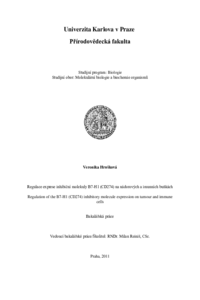Regulace exprese inhibiční molekuly B7-H1 (CD274) na nádorových a imunních buňkách.
Regulation of the B7-H1 (CD274) inhibitory molecule expression on tumour and immune cells.
bachelor thesis (DEFENDED)

View/
Permanent link
http://hdl.handle.net/20.500.11956/36679Identifiers
Study Information System: 95089
Collections
- Kvalifikační práce [20352]
Author
Advisor
Referee
Krulová, Magdaléna
Faculty / Institute
Faculty of Science
Discipline
Molecular Biology and Biochemistry of Organisms
Department
Department of Cell Biology
Date of defense
14. 6. 2011
Publisher
Univerzita Karlova, Přírodovědecká fakultaLanguage
Czech
Grade
Excellent
Kostimulační/inhibiční molekuly rodiny B7, které jsou exprimovány na antigen prezentujících a dalších buňkách, včetně nádorových, hrají důležitou roli v regulaci imunitní odpovědi. Molekuly vazbou přes receptor ovlivňují aktivitu T-lymfocytů a to jak pozitivně, tak negativně. Mezi významné členy této rodiny patří molekula B7-H1 (CD274, PD-L1). Je exprimována v různých tkáních těla, nejen v buňkách hematopoetické řady. Význačná je i její prezentace na povrchu mnoha nádorových buněk. B7-H1 má dva vazebné receptory v cytoplazmatické membráně T-lymfocytů. Jeden receptor nebyl zatím určen, druhým receptorem je PD-1 (CD279) molekula. Vazba mezi B7-H1 - PD-1 negativně reguluje proliferaci, diferenciaci a produkci cytokinů T-lymfocyty, což je důležité při tvorbě periferní tolerance a zároveň při úniku nádorových buněk v proti-nádorové odpovědi tvořené T- lymfocyty. Přestože mechanismy regulace exprese B7-H1 na povrchu buněk byly v posledních letech intenzivně studovány, zvláště v případě nádorových buněk nejsou plně objasněny. Exprese B7-H1 je ovlivněna hlavně cytokiny IFNγ a TNFα jak na transkripční úrovni, tak na post-transkripční úrovni. V promotoru molekuly se nacházejí vazebná místa pro transkripční faktor IRF-1 a NF-κB. IRF-1 je aktivován působením IFNγ. NF-κB je aktivován samotným TNFα, samotným...
The co-stimulatory/inhibitory molecules of family B7 that are expressed on the surface of antigen-presenting and other cells, including tumour cells, play an important role in immune responses regulations. Owing to binding on the T-lymphocyte receptors, they regulate their positive and also negative responses. An important co-stimulatory member of B7 family is B7-H1 molecule. This molecule is presented in many different tissues, not only on haematopoietic cells. However, it is also expressed on tumour cells. Its two binding receptors are in the cytoplasmic membrane of T-cells. The first receptor is unknown and the second receptor is PD-1 (CD279). The linkage between B7-H1 - PD-1 regulates negatively proliferation, differentiation and cytokine secretion of T-cells. This negative regulation is crucial for the constitution of peripheral immune tolerance and also for escape of tumour cells from T-lymphocyte based anti-tumour responses. Although the mechanisms underlying the B7-H1 cell-surface expression have been intensively studied, and they are not fully understood, especially in tumour cells. IFNγ and TNFα regulate B7-H1 expression on transcription level as well as on post- transcription level. Binding sites for transcription factors IRF-1 and NF-κB are located in B7- H1 promoter region. The IRF-1...
